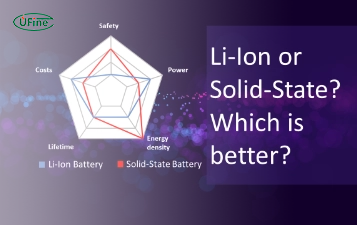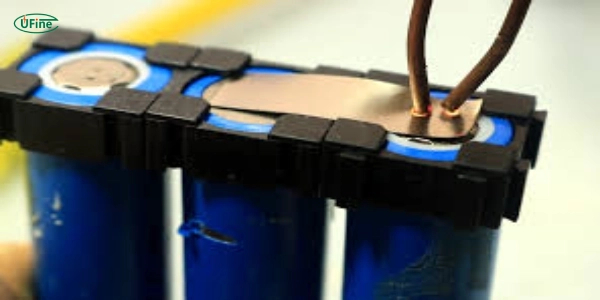
- Part 1. Understanding the battery spot welding process for lithium batteries
- Part 2. Preparing for battery spot welding lithium batteries
- Part 3. Battery spot welding procedure for lithium batteries
- Part 4. Tips and best practices for battery spot welding lithium batteries
- Part 5. FAQs about battery spot welder
A battery spot welder is a specialized tool for joining lithium battery cells using controlled electrical pulses. Unlike soldering, it creates strong, low-resistance connections by fusing nickel strips to battery terminals without damaging heat-sensitive components. This guide reveals professional techniques for achieving 0.1-0.5mΩ weld resistance – the industry standard for reliable battery packs.
Part 1. Understanding the battery spot welding process for lithium batteries
What is a battery spot welder?
A battery spot welder is a tool used for welding battery cells together by applying heat and pressure to nickel strips. It is commonly used in the assembly of lithium-ion battery packs.
Basics of Spot Welding
Battery spot welding is a technique that combines metal parts in lithium battery packs. This method is essential for creating reliable connections without damaging the battery cells. It uses heat and pressure to create a strong bond. Here are some key points to understand about spot welding:
- Principle: Spot welding works by passing an electric current through metal pieces. The current heats the metal, and pressure is applied to fuse them.
- How It Works: Two electrodes press the metal parts together. The current flows through the electrodes and the metal. The heat from the current melts the metal, and the pressure joins them.
- Why It’s Important: This method is quick and efficient. It creates strong connections without needing extra materials like solder, which makes it perfect for making battery packs. It also keeps the cells safe.
Critical Technical Specifications
| Parameter | Lithium Welding Range | Tool Requirement |
|---|---|---|
| Pulse Duration | 1-10ms | Adjustable timer |
| Output Current | 800-2000A | Capacitor-based system |
| Electrode Force | 50-150N | Spring-loaded tips |
| Nickel Thickness | 0.1-0.3mm | Pure nickel (≥99.6%) |
Choosing Your Battery Spot Welder
Not all welders handle lithium’s thin terminals well. Prioritize these features:
- Micro-Second Control: Look for 0.1ms adjustment increments to prevent cell damage
- Dual-Pulse Mode: Essential for welding 0.2mm+ nickel strips (common in EV batteries)
- Voltage Stabilization: Maintains consistent energy at ≥5,000μF capacitance
Part 2. Preparing for battery spot welding lithium batteries
Safety Precautions
Before you begin spot welding lithium batteries, it’s crucial to prioritize safety. Here are some essential safety measures:
- Wear Protective Gear: To protect yourself from heat and sparks, wear heat-resistant gloves, safety goggles, and non-flammable clothing.
- Ensure Proper Ventilation: Work in a well-ventilated area to prevent the buildup of harmful fumes from welding.
- Inspect Equipment: Check your spot welder and other tools for damage or defects before use to avoid accidents.
- Keep Fire Extinguisher Nearby: Have a fire extinguisher within reach in emergencies.
- Stay Alert: Avoid distractions and focus on the welding process to prevent accidents.
Preparing the Work Area
Creating the right work environment is essential for successful spot welding. Here’s how to prepare:
- Clean Work Surface: Clear your workbench of clutter or debris to create a clean and organized workspace.
- Avoid Flammable Materials: Remove any flammable materials from the vicinity of your work area to reduce the risk of fire.
- Secure Battery Holders: Ensure that battery holders are stable and securely positioned to prevent movement during welding.
- Position Welding Equipment: Place your spot welder and other tools within easy reach for convenience and efficiency.
Preparing the Lithium Batteries
Proper preparation of lithium batteries is crucial for successful spot welding. Follow these steps:
- Clean Battery Surfaces: Wipe the surfaces of the battery cells with a clean, dry cloth to remove any dirt, oil, or residue that could interfere with the welding process.
- Arrange Battery Cells: Arrange the battery cells in the desired configuration, ensuring they are aligned and spaced adequately for welding.
- Inspect Nickel Strips: Check the nickel strips for defects or damage and ensure they are the correct size and thickness for the battery cells.
- Secure Connections: Double-check that the connections between the battery cells and nickel strips are safe and free from obstructions.
Part 3. Battery spot welding procedure for lithium batteries
Setting Up the Spot Welder
To ensure successful lithium batteries’ spot welding, properly setting up and calibrating your spot welder is essential. Here’s a guide:
- Power Settings: Adjust the spot welder’s power settings according to the thickness of the nickel strips and the type of battery cells in use.
- Electrode Positioning: Position the spot welder electrodes to ensure they make good contact with both the nickel strip and the battery cell.
- Calibration: Calibrate the spot welder according to the manufacturer’s instructions to ensure accurate and consistent welds.
Performing the Spot Welds
You can begin the spot welding process once you set up the welder.
Follow these step-by-step instructions:
- Prepare the Weld Area: Place the prepared lithium batteries in the holder, ensuring they are securely positioned and aligned.
- Position Electrodes: Position the spot welder electrodes over the junction of the nickel strip and the battery cell.
- Apply Pressure: Press the electrodes firmly against the nickel strip and battery cell to ensure good contact.
- Activate Welder: Activate the spot welder to apply a brief but intense electrical current to the junction, melting the nickel strip and creating a solid weld.
- Repeat: Repeat the process for each junction between the battery cells and nickel strips, ensuring consistent weld quality.
Inspecting the Welds
After completing the spot welding process, it’s essential to inspect the welds to ensure they are solid and reliable. Here are some techniques for inspection:
- Visual Inspection: Inspect each weld to ensure no signs of incomplete fusion or weak spots.
- Tug Test: Gently tug on the nickel strips to check for any signs of separation from the battery cells.
- Multimeter Test: Use a multimeter to measure the resistance of each weld to ensure it falls within the desired range, indicating a solid connection.
- Reinforcement: If any welds are weak or inadequate, reinforce them by applying additional spot welds.
Part 4. Tips and best practices for battery spot welding lithium batteries
Choosing the Right Nickel Strips
Selecting the correct nickel strips is crucial for successful spot welding of lithium batteries. Here’s some advice:
- Thickness: Choose nickel strips that are the appropriate thickness for the battery cells. Thicker strips provide more strength but may require higher welding power.
- Width: For optimal contact and conductivity, ensure the width of the nickel strips matches the size of the battery terminals.
- Purity: Use high-purity nickel strips to minimize resistance and ensure efficient energy transfer during welding.
Troubleshooting Common Welding Issues
- Weak Weld (Strips Peel Off)
- Fix: Increase current by 100A increments
- Clean terminals with isopropyl alcohol
- Battery Terminal Damage
- Fix: Reduce pulse time below 3ms
- Use pointed electrodes
Managing Heat and Pressure
Controlling heat and pressure is essential to prevent damage to the battery cells during spot welding. Follow these tips:
- Adjust Power Settings: Set the spot welder to the appropriate power level based on the thickness of the nickel strips and the type of battery cells.
- Monitor Temperature: Keep an eye on the temperature of the battery cells during welding to prevent overheating. Pause if necessary to allow for cooling.
- Apply Even Pressure: Ensure that pressure is evenly distributed across the electrodes to prevent the battery cells from deforming or puncturing.
Ensuring Consistency and Accuracy
Consistency and accuracy are crucial to producing reliable welds throughout the battery pack. Here are some best practices:
- Maintain Electrode Alignment: Check the alignment of the spot welder electrodes regularly to ensure you correctly position them over the nickel strips and battery cells.
- Standardize Welding Technique: To achieve consistent results, develop and stick to a standardized welding technique throughout the welding process.
- Inspect Weld Quality: Periodically inspect the quality of the welds using visual inspection, tug tests, and multimeter measurements to identify any inconsistencies or defects.
- Practice Proper Welding Sequence: Follow a logical welding sequence, starting from one end of the battery pack and working your way across to ensure you make all connections efficiently and accurately.
Part 5. FAQs about battery spot welder
How does a battery spot welder work?
Battery spot welders operate in 3 critical phases:
- Compression where electrodes clamp nickel strips to battery terminals,
- Current Burst delivering 1000-2000A to melt contact points in 2-10ms, and
- Fusion where molten metals cool under pressure forming gas-tight connections with <0.5mΩ resistance – 5x stronger than soldered joints.
What’s the best battery spot welder for beginners?
Opt for models with adjustable current (800-1500A range), automatic pressure detection, and under $300 price point. Top recommendations include Malectrics MIC-801 and Kweld Portable Systems, which provide 0.1ms pulse control for safe 18650 battery welding.
How many volts are needed to spot weld lithium batteries?
Lithium battery spot welding requires 1-3 volts at high amperage (800-2000A). Critical factors are pulse duration (1-10ms) and electrode pressure (50-150N), not voltage alone. For 0.15mm nickel strips, 2.5V with 1200A current yields optimal nugget formation.
Is it safe to solder lithium batteries instead of spot welding?
Soldering lithium batteries is strongly discouraged. The 300°C+ heat damages cell internals, increases internal resistance by 15-30%, and risks thermal runaway. Spot welding keeps temperatures below 80°C, maintaining SEI layer integrity and manufacturer warranty validity.
What metals cannot be spot welded to lithium batteries?
High-resistivity metals like stainless steel (45μΩ·cm) and titanium require specialized equipment. Pure nickel strips (0.1-0.3mm) are mandatory for lithium packs due to their low 6.9μΩ·cm resistivity and thermal expansion coefficient matching battery terminals.
Can I spot-weld different lithium battery types together?
Only within matching specifications: Combine exclusively same-chemistry cells (e.g. Li-ion 18650s) with ≤0.02V voltage differential and identical capacity ratings. Mixing LiFePO4 with NMC cells creates dangerous imbalance – capacity variance must stay under 5%.
Can I spot-weld without professional equipment?
While possible with modified microwave transformers, DIY solutions risk inconsistent welds. Commercial spot welders maintain capacitor discharge stability – achieving 0.3mΩ connections vs DIY’s 2-5mΩ. For occasional use, consider $150-300 entry-level machines.
How to prevent lithium battery overheating during spot welding?
Implement three safeguards: 1) Limit pulse duration to 3ms max 2) Use copper-tungsten electrodes for 40% faster heat dissipation 3) Maintain 0.3-0.5mm electrode gap. Always monitor cell temperature with IR thermometer – abort if exceeding 50°C.
What nickel strip thickness is best for 18650 batteries?
Use 0.15mm pure nickel strips for standard 18650s (2-5A discharge). For high-drain applications (20A+), upgrade to 0.2mm with dual-pulse welding. Avoid nickel-plated steel – its 13.8μΩ·cm resistivity causes 25% higher heat generation.
Related Tags:
More Articles

Solid State Battery vs Lithium Ion: A Comparative Analysis
Compare solid-state and lithium-ion batteries in safety, energy, charging speed, cost, and lifespan. See which works best for EVs, phones, and storage.
Learn safe LiPo battery storage tips, including charge levels, temperature, and humidity control, to extend battery life and prevent risks.
18650 Battery 4.2V VS 3.7V: What is Different?
Compare 18650 batteries: 4.2V vs 3.7V. Learn what V stands for, voltage differences, charging, applications, and which battery suits your device.
How Long Do Rechargeable AA Batteries Last?
Rechargeable AA batteries last 2–10 years (500–2000 cycles). Compare NiMH vs Lithium, tips to extend life, and when to replace batteries.
Industrial Battery vs. Regular Battery: A Complete Comparison
Compare industrial vs regular batteries by lifespan, performance, and cost. Learn which type suits forklifts, solar systems, tools, or common household devices.



